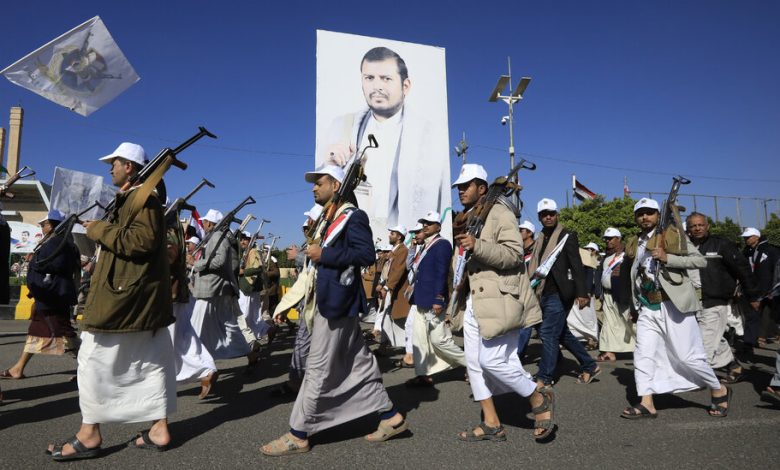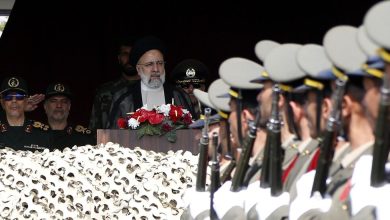Who Are the Houthis, and Why Are They Attacking Ships in the Red Sea?

Since mid-November, the Houthis, a Yemeni rebel group allied with Hamas and backed by Iran, have launched dozens of attacks on ships sailing through the Red Sea and the Suez Canal, a crucial shipping route through which 12 percent of world trade passes.
Early Friday morning, the United States and a handful of allies, including Britain, struck back, carrying out missile strikes on Houthi targets inside Yemen and thrusting the rebels and their long-running armed struggle further into the limelight.
The attack on Houthi bases came a day after the United Nations Security Council voted to condemn “in the strongest terms” at least two dozen attacks carried out by the Houthis on merchant and commercial vessels, which it said had impeded global commerce and undermining navigational freedom.
Here’s a primer on the Houthis, their relationship with Hamas and the attacks in the Red Sea.
Who are the Houthis?
The Houthis, led by Abdul-Malik al-Houthi, are an Iran-backed group of Shiite rebels who have been fighting Yemen’s government for about two decades and now control the country’s northwest and its capital, Sana.
They have built their ideology around opposition to Israel and the United States, seeing themselves as part of the Iranian-led “axis of resistance,” along with Hamas in the Gaza Strip and Hezbollah in Lebanon. Their leaders often draw parallels between the American-made bombs used to pummel their forces Yemen and the arms sent to Israel and used in Gaza.
In 2014, a military coalition led by Saudi Arabia intervened to try to restore the country’s original government after the Houthi’s seized the capital, starting a civil war that has killed hundreds of thousands.
Last April, talks between the Houthis and Saudi Arabia raised hopes for a peace deal that would potentially recognize the Houthis’s right to govern northern Yemen.
Once a group of poorly organized rebels, the Houthis have bolstered their arsenal in recent years, and it now includes cruise and ballistic missiles and long-range drones. Analysts credit this expansion to support from Iran, which has supplied militias across the Middle East to expand its own influence.
Why are they attacking ships in the Red Sea?
When the Israeli-Hamas war started on Oct. 7, the Houthis declared their support for Hamas and said they would target any ship traveling to Israel or leaving it.
Yahya Sarea, a Houthi spokesman, has said frequently that the group is attacking ships to protest the “killing, destruction and siege” in Gaza and to stand in solidarity with the Palestinian people.
The Gazan authorities say that more than 23,000 people, most of them civilians, have been killed in the Israeli bombing campaign and ground offensive that started after Hamas carried out cross-border raids and massacred, the Israeli authorities say, about 1,200 people.
Since November, the Houthis have launched 27 attacks with drones and missiles on vessels in the Red Sea and the Gulf of Aden that they claim are heading toward or leaving Israeli ports. The latest was on Thursday at 2 a.m., when a missile landed near a commercial vessel, the U.S. military said.
Perhaps the most audacious Houthi operation came in Nov. 19, when gunmen hijacked a vessel named the Galaxy Leader and took it to a Yemeni port, holding its 25 crew members, mainly Filipinos, captive.
How are the attacks affecting countries around the world?
Speaking to reporters in Bahrain on Wednesday, the American secretary of state, Antony J. Blinken, warned that continued Houthi attacks in the Red Sea could disrupt supply chains and in turn increase costs for everyday goods. The Houthis attacks have affected ships tied to more than 40 countries, he said.
The world’s biggest container companies, MSC and Maersk, have said they are avoiding the region, and shipping companies are left with difficult options.
Rerouting vessels around Africa adds an extra 4,000 miles and 10 days to shipping routes, and requires more fuel. But continuing to use the Red Sea would raise insurance premiums. Either option would bruise an already fragile global economy.
What has the U.S. been doing to stop the Houthi attacks?
The Biden administration repeatedly condemned Houthi attacks in the Red Sea and assembled a naval task force to try keep them in check.
The task force, called Operation Prosperity Guardian, brought together the United States, Britain and other allies and has been patrolling the Red Sea to, in Mr. Blinken’s words, “preserve freedom of navigation” and “freedom of shipping.”
Bahrain is the only Middle Eastern country that agreed to participate. Even though many countries in the region depend on trade that goes through the Red Sea, many do not want to be associated with the United States, Israel’s closest ally, analysts say.
U.S. and British warships have intercepted some Houthi missiles and drones before they reached their targets. On Wednesday, American fighter jets from the aircraft carrier U.S.S. Dwight D. Eisenhower, along with four other warships, intercepted 18 drones, two anti-ship cruise missiles and one anti-ship ballistic missile, Central Command said in a statement.
On Dec. 31, U.S. Navy helicopters sank three Houthi boats that were attacking a commercial freighter.
Ben Hubbard, Peter Eavis, and Keith Bradsher contributed reporting.



